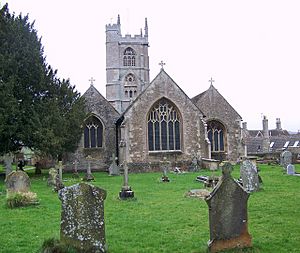Church of St Philip and St James, Norton St Philip facts for kids
Quick facts for kids Church of St Philip and St James |
|
|---|---|
 |
|
| Location | Norton St Philip, Somerset, England |
| Built | 13th and 14th century |
|
Listed Building – Grade II*
|
|
| Designated | 11 March 1968 |
| Reference no. | 1345373 |
| Lua error in Module:Location_map at line 420: attempt to index field 'wikibase' (a nil value). | |
The Church of St Philip and St James is a very old and important church. It is located in the village of Norton St Philip in Somerset, England. This church is a special historic building, known as a Grade II* listed building. This means it is protected because of its history and unique design. The church is part of a group of local churches called the Hardington Vale benefice.
A Look Back in Time
The church building you see today has parts that are from the 13th and 14th centuries. That's a very long time ago! It's even possible that a church stood on this spot before the Norman Conquest in 1066.
In 1345, a special market, or "fair," was moved to Norton St Philip. This fair brought a lot of money to the village. Much of this money helped support the church.
A famous writer named Samuel Pepys visited the church in the 1600s. He wrote about a tomb he saw there. People first thought it belonged to a Knight Templar, a medieval knight. But now, experts believe it was the tomb of a lawyer or merchant from the 1460s. Pepys also shared a story about the "Fair Maids of Foscott." These were believed to be conjoined twins from a nearby village, now called Foxcote.
The north side of the church, called the aisle, was likely added in the 1600s.
A big renovation happened in the 1840s. This was part of a "Victorian restoration" movement. A famous architect named George Gilbert Scott led this work. More recently, in 2000, the church had more updates. New wooden and steel rooms were added. These included a vestry, toilets, and meeting spaces. This project was called "The Hub." Because of "The Hub" and how it helps the community, the church won an award in 2008. It was called the "Village Church for Village Life Award."
What the Church Looks Like
The church is built from a type of stone called Doulting Stone. Some parts are rough, known as rubble. Other parts are smoother, called ashlar, especially on the south and east sides. These smoother parts were probably added during the 1800s renovations. The roof is made of slate tiles and covers an oak barrel roof inside. The church also has a tall, three-part tower on its west side.
The tower has a clock that was made in 1841. It was created by Benjamin Lewis Vulliamy and Charles Frodsham. The tower also holds six bells.
The large window at the east end of the church has beautiful stained glass artwork. This glass was designed by Christopher Webb. Other windows in the church have even older glass, which is very special.
Inside the church, you can find memorials. One memorial remembers a soldier who died in Norton St Philip in 1643. This happened during the English Civil War. The village also saw more military events during a conflict called the Monmouth Rebellion.

